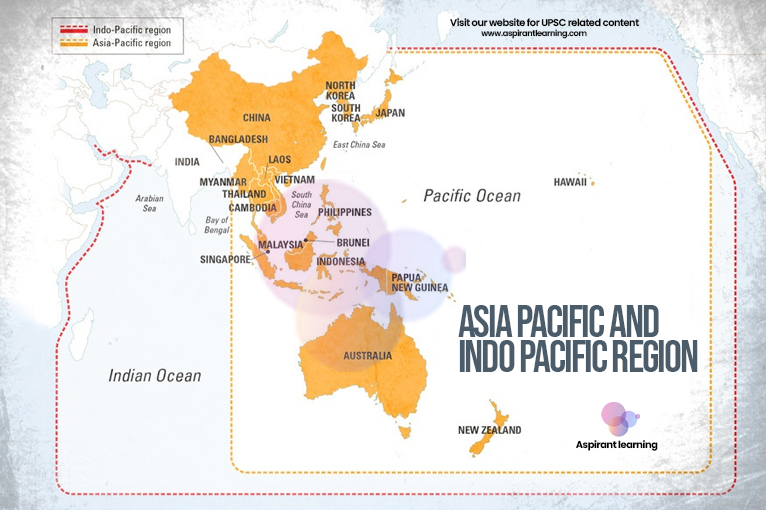News Highlight
Voices from India’s Northeast and eastern regions must be heard in implementing the country’s Indo-Pacific strategy.
Key Takeaway
Since 2018, India’s ‘Look East’ and ‘Act East’ policy has shifted to an Indo-Pacific policy and strategy.
India in Indo-Pacific
- The Indo-Pacific is gaining prominence due to several strategic powers’ common interests and convergences, each with its influences and ambitions.
- The three emerging geostrategic and geo-economics shifts are
- The maritime and blue economy will dominate strategic competition over the next several decades.
- The Indo-Pacific covers a diverse and significant region that envelopes Southeast Asia, South Asia and the coastal nations of the Indian Ocean.
- China’s rise, outward expansion, and the escalation of the US-China rivalry.
- India’s economic ties with Indo-Pacific
- The heart of India’s economic ties in the Indo-Pacific is rooted in the Indian Ocean.
- The Indian Ocean covers nearly 20% of the world’s ocean area, touching 36 countries and connecting three continents (Africa, Asia and Australia).
- The Indian Ocean contains critical sea lanes and chokes points for global trade, connecting major international economic centres in the North Atlantic and Asia-Pacific.
- Approximately 40% of the world’s oil supply passes through strategic choke points into and out of the Indian Ocean, which also serves as a valuable source of mineral and fishing resources.
- India’s economic future in the Indo-Pacific region will broadly be defined by its capacity to build on its blue economy potential (ranging across several sectors), regional economic integration (trade agreements to address trade barriers) and connectivity infrastructure to promote intra-inter regional trade (ports and logistics) in the Indian Ocean.
- Advancing India’s interest in the Indo-Pacific
- At the core of the Indo-Pacific region is a collection of sub-regions of diverse countries, each with different strengths, capabilities and capacities.
- ASEAN is central to India’s Indo-Pacific strategy.
- India’s evolving ties with Australia, with the elevation of the relationship to a Comprehensive Strategic Partnership.
- The revival of the QUAD and SCRI grouping were motivated by shifts in the regional order in the Indo-Pacific.
- Economic growth in Indo-Pacific countries can only be revived by sound economic (power, water and transport) and social infrastructure (education and health).
- India’s Indo-Pacific expanse primarily covers
- Matters of Indo-Pacific include the QUAD and trilateral groupings.
- India–ASEAN relations
- Indian Ocean Rim Association (IORA)
- The East Asia Summit
- Asia–Europe Meeting (ASEM)
- The Mekong–Ganga Cooperation (MGC) includes India and five ASEAN countries: Cambodia, Lao PDR, Myanmar, Thailand and Vietnam.
- Oceania includes Australia, New Zealand and Pacific Island countries.
Indo-Pacific region
- About
- India’s definition of the Indo-Pacific region stretches from the western coast of North America to the eastern shores of Africa.
- The region comprises at least 38 countries and accounts for 44% of the world’s land area.
- The region is home to more than 64% of the world’s population and accounts for 62% of global GDP, with more than 50% of global trade passing through its waters.
- The region is highly heterogeneous, with countries at different levels of development connected by a common thread of ‘the ocean’.

Way Forward
- India should prioritise creating a full-fledged Ministry of Blue Economy with an effective institutional mechanism for coordination and leadership.
- India will need to develop a multi-layered approach to cooperation in the region by aligning its strengths and priorities with those of other countries, building centres for facilitating inter-state trade with a focus on niche goods and services and using technology to build responsive processes.
- Maritime Domain Awareness (MDA) is necessary for Indo-Pacific security.
- India must maintain its Indian Ocean vision, SAGAR – Security and Growth for All in the Region
Conclusion
- The ‘new normal of economic diplomacy should strive for a balance of competition and cooperation, aspirations and reality, regional and global. A solid foundation of rules-based collaboration should steer it. The collective action of the Indo-Pacific region in India will determine its development as a key player. Reimagination, reform, resolve, and resilience based on trust and transparency are required. It is no longer about rising India but about how India can lead.
Pic Courtesy: freepik
Content Source: The Hindu



